树及其衍生算法(Trees and tree algorithms)
1,二叉树(Binary tree)
二叉树:每一个节点最多两个子节点,如下图所示:

相关概念:节点Node,路径path,根节点root,边edge,子节点 children,父节点parent,兄弟节点sibling, 子树subtree,叶子节点leaf node, 度level,树高hight

节点Node:
路径path:从一个节点到拧一个节点间的边
根节点root,
边edge:节点间的连线
子节点 children,
父节点parent,
兄弟节点sibling,
子树subtree,
叶子节点leaf node,
度level:从当前节点到根节点的路径中边的数量
高度 hight:树中所有节点的最大level
二叉树可以通过多级列表的形式实现,多级列表形式如下,根节点r,有两个子节点a , b,且a, b节点没有子节点。
mytree =[ r,
[ a, [ ], [ ] ], [ b, [ ], [ ] ]
]
python实现代码如下:

#coding:utf-8 #多级列表实现 def binaryTree(r): return [r,[],[]] #root[]为根节点,root[1]左子树,root[2]右子树 def insertLeftTree(root,newbranch): t = root.pop(1) if len(t)>1: root.insert(1, [newbranch, t, []]) else: root.insert(1,[newbranch, [], []]) return root def insertRightTree(root,newbranch): t = root.pop(2) if len(t)>1: root.insert(2, [newbranch, [], t]) else: root.insert(2,[newbranch, [], []]) return root def getRootVal(root): return root[0] def setRootVal(root,val): root[0]= val def getLeftChildren(root): return root[1] def getRightChildren(root): return root[2] r = binaryTree(3) insertLeftTree(r,4) insertLeftTree(r,5) insertRightTree(r,6) insertRightTree(r,7) l = getLeftChildren(r) print(l) setRootVal(l,9) print(r) insertLeftTree(l,11) print(r) print(getRightChildren(getRightChildren(r)))
二叉树可以通过节点的形式实现,如下所示:

python实现代码如下:

class BinaryTree(object): def __init__(self,value): self.key = value self.leftChild = None self.rightChild = None def insertLeft(self,newNode): if self.leftChild != None: temp = BinaryTree(newNode) temp.leftChild = self.leftChild self.leftChild = temp else: self.leftChild = BinaryTree(newNode) def insertRight(self,newNode): if self.rightChild != None: temp = BinaryTree(newNode) temp.rightChild= self.rightChild self.rightChild = temp else: self.rightChild = BinaryTree(newNode) def getRootVal(self): return self.key def setRootVal(self,value): self.key = value def getLeftChild(self): return self.leftChild def getRightChild(self): return self.rightChild
2,二叉树的应用
2.1 解析树(parse tree)
解析树常用于表示真实世界的结构表示,如句子和数学表达式。如下图是((7+3)*(5-2))的解析树表示,根据解析树的层级结构,从下往上计算,能很好的代替括号的表达式中括号的作用
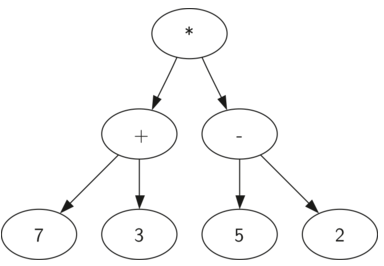
将一个全括号数学表达式转化为解析树的过程如下:
遍历表达式:
1,若碰到“(”,为当前节点插入左节点,并移动到左节点
2,若碰到 + ,- ,* , /,设置当前节点的值为该符号,并为当前节点插入右节点,并移动到右节点
3,若碰到数字,设置当前节点的值为该数字,并移动到其父节点
4,若碰到“)”,移动到当前节点的父节点
python实现代码如下:(Stack 参见数据结构之栈 )

from stackDemo import Stack #参见数据结构之栈 def buildParseTree(expstr): explist = expstr.split() s = Stack() t = BinaryTree('') s.push(t) current = t for token in explist: #token = token.strip() if token =='(': current.insertLeft('') s.push(current) current = current.getLeftChild() elif token in ['*','/','+','-']: current.setRootVal(token) current.insertRight('') s.push(current) current = current.getRightChild() elif token not in ['(','*','/','+','-',')']: current.setRootVal(token) current = s.pop() elif token==')': current = s.pop() else: raise ValueError return t t = buildParseTree("( ( 10 + 5 ) * 3 )")
计算解析树:数学表达式转化为解析树后,可以对其进行计算,python代码如下:

import operator def evaluate(parseTree): operators={'+':operator.add,'-':operator.sub,'*':operator.mul,'/':operator.div } rootval = parseTree.getRootVal() left = parseTree.getLeftChild() right = parseTree.getRightChild() if left and right: fn = operators[rootval] return fn(evaluate(left),evaluate(right)) else: return parseTree.getRootVal()
中序遍历解析树,可以将其还原为全括号数学表达式,python代码如下:

#解析树转换为全括号数学表达式 def printexp(tree): val = '' if tree: val = '('+printexp(tree.getLeftChild()) val = val +str(tree.getRootVal()) val = val +printexp(tree.getRightChild())+')' if tree.getLeftChild()==None and tree.getRightChild()==None: val = val.strip('()') return val t = buildParseTree("( ( 10 + 5 ) * 3 )") exp = printexp(t) print exp
3,树的遍历
树的遍历包括前序遍历(preorder),中序遍历(inorder)和后序遍历(postorder).
前序遍历:先访问根节点,再访问左子树,最后访问右子树(递归),python代码实现如下:

def preorder(tree): if tree: print tree.getRootVal() preorder(tree.getLeftChild()) preorder(tree.getRightChild()) #定义在类中的前序遍历 # def preorder(self): # print self.key # if self.leftChild: # self.leftChild.preorder() # if self.rightChild: # self.rightChild.preorder()
中序遍历:先访问左子树,再访问根节点,最后访问右子树(递归),python代码实现如下:

#中序遍历inorder def inorder(tree): if tree: preorder(tree.getLeftChild()) print tree.getRootVal() preorder(tree.getRightChild())
后续遍历:先访问左子树,再访问右子树,最后访问根节点,python代码实现如下:

def postorder(tree): if tree : postorder(tree.getLeftChild()) postorder(tree.getRightChild()) print(tree.getRootVal())
树的层次遍历,树的深度,前序遍历和中序遍历构建树,判断两棵树是否相同:

class TreeNode(object): def __init__(self, data, leftchild=None, rightchild=None): self.data = data self.leftchild = leftchild self.rightchild = rightchild def preorder(self): print self.data if self.leftchild: self.leftchild.preorder() if self.rightchild: self.rightchild.preorder() def midorder(self): if self.leftchild: self.leftchild.preorder() print self.data if self.rightchild: self.rightchild.preorder() t1 = TreeNode(4,TreeNode(3,TreeNode(5,TreeNode(10)),TreeNode(8)),TreeNode(9,TreeNode(7),TreeNode(12))) # #层次遍历 def lookup(root): row=[root] while row: print [x.data for x in row] temp=[] for item in row: if item.leftchild: temp.append(item.leftchild) if item.rightchild: temp.append(item.rightchild) row = temp lookup(t1) #树的深度 def get_height(root): if root ==None: return 0 return max(get_height(root.leftchild),get_height(root.rightchild))+1 print(get_height(t1)) #根据前序遍历和中序遍历构建树 pre=[4,3,5,10,8,9,7,12] # t1.preorder() mid=[3,5,10,8,4,9,7,12] # t1.midorder() def build(pre,mid): if not pre: return None node = TreeNode(pre[0]) index = mid.index(pre[0]) node.leftchild = build(pre[1:index+1],mid[:index]) node.rightchild = build(pre[index+1:],mid[index+1:]) return node tt = build(pre,mid) tt.preorder() #判断两棵树是否相同 t1 = TreeNode(4,TreeNode(3,TreeNode(5,TreeNode(10)),TreeNode(8)),TreeNode(9,TreeNode(7),TreeNode(12))) t2 = TreeNode(4,TreeNode(3,TreeNode(5,TreeNode(10)),TreeNode(8)),TreeNode(9,TreeNode(7),TreeNode(12))) t3 = TreeNode(4,TreeNode(3,TreeNode(8,TreeNode(40)),TreeNode(13)),TreeNode(9,TreeNode(7),TreeNode(12))) def is_same_tree(t1,t2): if t1==None and t2==None: return True elif t1 and t2: return is_same_tree(t1.leftchild,t2.leftchild) and t1.data==t2.data and is_same_tree(t1.rightchild,t2.rightchild) else: return False print(is_same_tree(t1,t2)) print(is_same_tree(t1,t3))
morris 遍历:上面的前中后序遍历方法都使用了递归,需要额外的空间,morris 遍历为非递归,空间复杂度为O(1), 当二叉树数据量庞大时更加适用
Morris遍历算法的步骤如下:(中序遍历)
1, 根据当前节点,找到其前序节点,如果前序节点的右孩子是空,那么把前序节点的右孩子指向当前节点,然后进入当前节点的左孩子。
2, 如果当前节点的左孩子为空,打印当前节点,然后进入右孩子。
3,如果当前节点的前序节点其右孩子指向了它本身,那么把前序节点的右孩子设置为空,打印当前节点,然后进入右孩子。
前序节点:给定某个节点,在中序遍历中,直接排在它前面的节点,我们称之为该节点的前序节点
前序节点寻找算法:
如果该节点有左孩子,那么从左孩子开始,沿着左孩子的右孩子指针一直向下走到底,得到的节点就是它的前序节点

class TreeNode(object): def __init__(self, data, leftchild=None, rightchild=None): self.data = data self.leftchild = leftchild self.rightchild = rightchild def preorder(self): print self.data if self.leftchild: self.leftchild.preorder() if self.rightchild: self.rightchild.preorder() def midorder(self): if self.leftchild: self.leftchild.midorder() print self.data if self.rightchild: self.rightchild.midorder() t1 = TreeNode(4,TreeNode(3,TreeNode(5,TreeNode(10)),TreeNode(8)),TreeNode(9,TreeNode(7),TreeNode(12))) #morris遍历 def morris(root): if root==None: return None cur=root while cur!=None: if cur.leftchild==None: print cur.data cur = cur.rightchild else: pre = get_predecessor(cur) if pre.rightchild==None: pre.rightchild=cur cur = cur.leftchild elif(pre.rightchild==cur): pre.rightchild=None print cur.data cur = cur.rightchild def get_predecessor(node): pre = node if pre.leftchild!=None: pre = pre.leftchild while pre.rightchild!=None and pre.rightchild!=node: pre = pre.rightchild return pre t1.midorder() print("="*20) morris(t1)
4,优先队列和二叉堆(priority queue and binary heap)
优先队列:优先队列和队列类似,enqueue操作能加入元素到队列末尾,dequeue操作能移除队列首位元素,不同的是优先队列的元素具有优先级,首位元素具有最高或最小优先级,因此当进行enqueue操作时,还需要根据元素的优先级将其移动到适合的位置。优先队列一般利用二叉堆来实现,其enqueue和dequeue的复杂度都为O(logn)。(也可以用list来实现,但list的插入复杂度为O(n),再进行排序的复杂度为O(n logn))
二叉堆:二叉堆是一颗完全二叉树,当父节点的键值总是大于或等于任何一个子节点的键值时为最大堆,当父节点的键值总是小于或等于任何一个子节点的键值时为最小堆。(完全二叉树:除最后一层外,每一层上的节点数均达到最大值;在最后一层上只缺少右边的若干结点;满二叉树:除叶子结点外的所有结点均有两个子结点。节点数达到最大值。所有叶子结点必须在同一层上)
最小堆示例及操作如下:(父节点的值总是小于或等于子节点)

BinaryHeap() #创建空的二叉堆 insert(k) #插入新元素 findMin() #返回最小值,不删除 delMin() #返回最小值,并删除 isEmpty() size() buildHeap(list) #通过list创建二叉堆
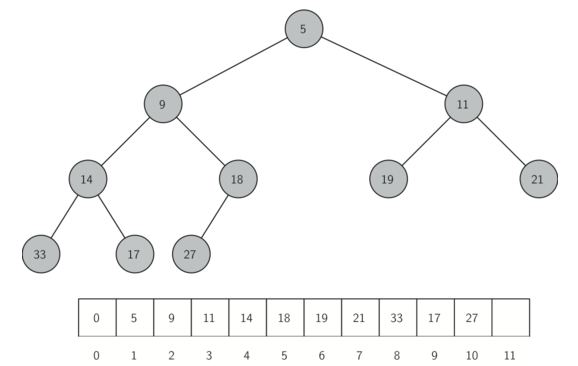
对于完全二叉树,若根节点的序号为p,则左右节点的序号应该为2p和2p+1,结合上图可以发现,可以用一个队列(首位元素为0)来表示二叉堆的结构。最小堆的python实现代码如下:(heaplist中第一个元素为0,不会用到,只是为了保证二叉堆的序列从1开始,方便进行除和乘2p,2p+1)

#coding:utf-8 class BinaryHeap(object): def __init__(self): self.heapList=[0] self.size = 0 #将元素加到完全二叉树末尾,然后再根据其大小调整其位置 def insert(self,k): self.heapList.append(k) self.size = self.size+1 self._percUp(self.size) # 如果当前节点比父节点小,和父节点交换位置,一直向上重复该过程 def _percUp(self,size): i = size while i>0: if self.heapList[i]<self.heapList[i//2]: temp = self.heapList[i] self.heapList[i] = self.heapList[i//2] self.heapList[i//2] = temp i=i//2 # 将根元素返回,并将最末尾元素移动到根元素保持完全二叉树结构不变,再根据大小,将新的根元素向下移动到合适的位置 def delMin(self): temp = self.heapList[1] self.heapList[1]=self.heapList[self.size] self.size = self.size-1 self.heapList.pop() self._percDown(1) return temp # 如果当前节点比最小子节点大,和该子节点交换位置,一直向下重复该过程 def _percDown(self,i): while (2*i)<=self.size: mc = self._minChild(i) if self.heapList[i]>self.heapList[mc]: temp = self.heapList[i] self.heapList[i]=self.heapList[mc] self.heapList[mc] =temp i = mc #返回左右子节点中较小子节点的位置 def _minChild(self,i): if (2*i+1)>self.size: return 2*i else: if self.heapList[2*i] < self.heapList[2*i+1]: return 2*i else: return 2*i+1 #通过一个list建立二叉堆 def buildHeap(self,list): i = len(list)//2 self.heapList = [0]+list[:] self.size = len(list) while i>0: self._percDown(i) i = i-1
insert()插入过程示例图如下:将元素加到完全二叉树末尾,然后再根据其大小调整其位置


delMin()操作过程示例如下:将根元素返回,并将最末尾元素移动到根元素保持完全二叉树结构不变,再根据大小,将新的根元素向下移动到合适的位置
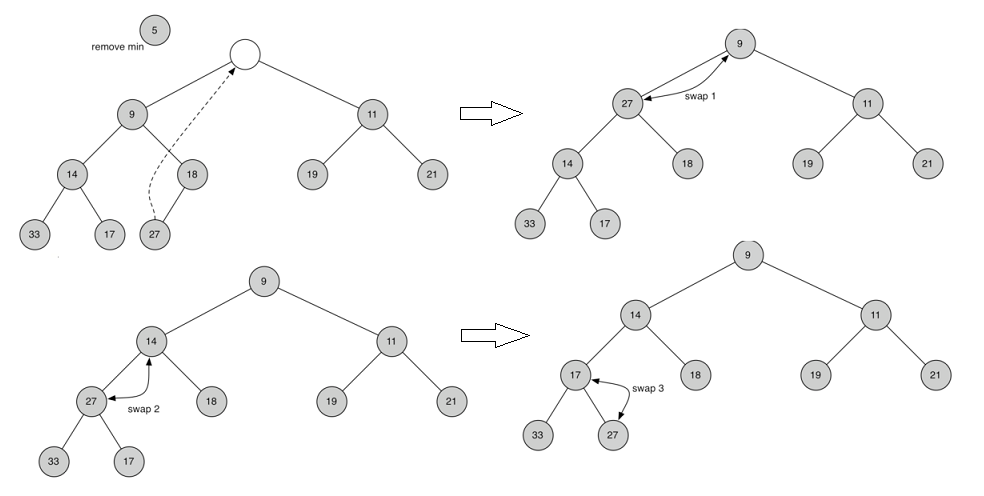
insert和delMin的复杂度都为O(log n), buildHeap的复杂度为O(n),利用二叉堆对list进行排序,复杂度为O(n log n),代码如下:

#通过list构造二叉堆,然后不断将堆顶元素返回,就得到排序好的list alist = [54,26,93,17,98,77,31,44,55,20] h = BinaryHeap() h.buildHeap(alist) s=[] while h.size>0: s.append(h.delMin()) print s

#堆排序 def build_min_heap(alist): size = len(alist) hq = [0]+alist i = len(alist)//2 while i>0: movedown(hq,i,size) i = i-1 return hq def movedown(hq,i,size): while (2*i)<=size: small = 2*i if 2*i+1<=size and hq[2*i]>hq[2*i+1]: small = 2*i+1 if hq[i]>hq[small]: hq[i],hq[small] = hq[small],hq[i] i = small def heappop(hq): temp = hq[1] hq[1]=hq[-1] hq.pop() movedown(hq,1,len(hq)-1) return temp alist = [2,4,6,7,1,2,5,25,15,20,1,21,33,18,29] q = build_min_heap(alist) t = [] for i in range(len(alist)): t.append(heappop(q)) print t

#coding:utf-8 #堆排序 def build_max_heap(alist): length = len(alist) for i in range(length/2,-1,-1): heapify(alist,i,length) def heapify(alist,i,length): left = 2*i+1 right = 2*i+2 largest = i if left<length and alist[left]>alist[largest]: largest = left if right<length and alist[right]>alist[largest]: largest = right if largest!=i: swap(alist,i,largest) heapify(alist,largest,length) def swap(alist,i,j): alist[i],alist[j] = alist[j],alist[i] def heapsort(alist): length = len(alist) build_max_heap(alist) for i in range(len(alist)-1,0,-1): swap(alist,0,i) length = length-1 heapify(alist,0,length) return alist alist = [2,4,6,7,1,2,5,80,10,9,25,15,20,1,21,33,18,29] print(heapsort(alist))
5,二叉搜索树(Binary Search Tree, bst)
二叉搜索树:左节点的值,总是小于其父节点的值,右节点的值总是大于其父节点的值(bst property)。如下图所示:
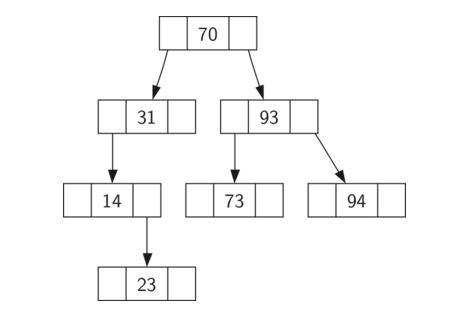
利用python实现二叉搜索树代码如下:

#二叉查找树 class TreeNode(object): def __init__(self,value,leftchild=None,rightchild=None,parent=None): self.value = value self.leftchild = leftchild self.rightchild = rightchild self.parent = parent def is_leaf(self): return not self.leftchild and not self.rightchild def is_leftchild(self): return self.parent.leftchild==self def is_rightchild(self): return self.parent.rightchild==self def has_both_children(self): return self.leftchild and self.rightchild def has_left_child(self): return self.leftchild def has_right_child(self): return self.rightchild def delete(self): if self.is_leftchild(): self.parent.leftchild=None elif self.is_rightchild(): self.parent.rightchild=None class BinarySearchTree(object): def __init__(self,node=None): self.root=node self.size = 0 def length(self): return self.szie def insert(self,value): if self.root==None: self.root = TreeNode(value) else: self._insert(self.root,value) def _insert(self,node,value): if node.value>value: if node.leftchild: self._insert(node.leftchild,value) else: temp = TreeNode(value) node.leftchild=temp temp.parent = node elif node.value<value: if node.rightchild: self._insert(node.rightchild,value) else: temp = TreeNode(value) node.rightchild=temp temp.parent = node else: print("%s已经存在"%value) def search(self,value): if self.root==None: return None else: return self._search(self.root,value) def _search(self,node,value): if node==None: return None if node.value>value: return self._search(node.leftchild,value) elif node.value<value: return self._search(node.rightchild,value) else: return node def delete(self,value): node = self._search(self.root,value) if node==None: return None if node.is_leaf(): #删除节点为叶子结点 node.delete() elif node.has_both_children(): #删除节点有两个孩子 successor = self.find_min(node) node.value = successor.value if successor.is_leaf(): successor.delete() else: #successor 只可能有一个右节点 if successor.is_leftchild(): successor.parent.leftchild = successor.rightchild elif successor.is_rightchild(): successor.parent.rightchild = successor.rightchild successor.rightchild.parent = successor.parent else: #删除节点只有一个孩子 if node.has_left_child(): if node.is_leftchild(): node.parent.leftchild=node.leftchild node.leftchild.parent=node.parent elif node.is_rightchild: node.parent.rightchild = node.leftchild node.leftchild.parent = node.parent elif node.has_right_child(): if node.is_leftchild(): node.parent.leftchild = node.rightchild node.rightchild.parent = node.parent elif node.is_rightchild(): node.parent.rightchild = node.rightchild node.rightchild.parent = node.parent def find_min(self,node): cur = node.rightchild while cur.leftchild: #右子树的最小值 cur = cur.leftchild return cur def traverse(self): row=[self.root] while row: print([i.value for i in row]) temp=[] for node in row: if node.leftchild: temp.append(node.leftchild) if node.rightchild: temp.append(node.rightchild) row = temp if __name__=='__main__': root = BinarySearchTree() root.insert(18) root.insert(13) root.insert(8) root.insert(16) root.insert(28) root.insert(20) root.insert(38) root.traverse() root.insert(17) root.insert(10) print(root.search(16)) print(root.search(12)) print("*"*30) root.traverse() # print("delete leaf") # root.delete(10) # root.traverse() # print("delete node with one child") # root.delete(16) # root.traverse() print("delete node with two children") root.delete(13) root.traverse()
上述代码中,进行节点删除时注意有三种情况:
删除节点为叶子结点:直接删除节点,然后将其父节点的左子节点或右子节点设为None
删除节点有一个孩子节点:利用子节点代替删除节点原来的位置
删除节点有两个孩子节点:找到删除节点的后继节点(其左子树的最右边节点,或者是其右子树的最左边节点),利用后继节点代替该节点的位置
利用二叉搜索树可以实现map(字典),常用操作如下:

Map() # 创建字典 put(key,val) # 字典中插入数据 get(key) # 取键值 del # 删除 len() # 求长度 in # 是否存在
python实现map代码如下:

#coding:utf-8 class TreeNode(object): def __init__(self,key, value, leftChild=None,rightChild=None,parent=None): self.key = key self.value = value self.leftChild = leftChild self.rightChild = rightChild self.parent = parent self.balanceFactor =0 def hasLeftChild(self): return self.leftChild def hasRightChild(self): return self.rightChild def isLeftChild(self): return self.parent and self.parent.leftChild==self def isRightChild(self): return self.parent and self.parent.rightChild==self def isRoot(self): return not self.parent def isLeaf(self): return not (self.leftChild or self.rightChild) def hasAnyChildren(self): return self.leftChild or self.rightChild def hasBothChildren(self): return self.leftChild and self.rightChild def replaceNodeData(self,key,value,lc=None,rc=None): self.key=key self.value = value self.leftChild = lc self.rightChild = rc if self.hasLeftChild(): self.leftChild.parent = self if self.hasRightChild(): self.rightChild = self def __iter__(self): if self: if self.hasLeftChild(): for elem in self.leftChild: #调用self.leftChiLd.__iter__(),所以此处是递归的 yield elem yield self.key, self.value, self.balanceFactor if self.hasRightChild(): for elem in self.rightChild: #调用self.rightChiLd.__iter__() yield elem def findSuccessor(self): #寻找继承 succ = None if self.hasRightChild(): succ = self.rightChild._findMin() else: if self.parent: if self.isLeftChild(): succ = self.parent else: self.parent.rightChild = None succ = self.parent.findSuccessor() self.parent.rightChild = self return succ def _findMin(self): current = self while current.hasLeftChild(): current = current.leftChild return current def spliceOut(self): if self.isLeaf(): if self.isLeftChild(): self.parent.leftChild=None else: self.parent.rightChild=None elif self.hasAnyChildren(): if self.hasLeftChild(): if self.isLeftChild(): self.parent.leftChild = self.leftChild else: self.parent.rightChild = self.leftChild self.leftChild.parent = self.parent else: if self.isLeftChild(): self.parent.leftChild = self.rightChild else: self.parent.rightChild = self.rightChild self.rightChild.parent = self.parent class BinarySearchTree(object): def __init__(self): self.root = None self.size = 0 def length(self): return self.size def __len__(self): return self.size def __iter__(self): return self.root.__iter__() #加入元素 def put(self,key,value): if self.root: self._put(key,value,self.root) else: self.root = TreeNode(key,value) self.size = self.size+1 def _put(self,key,value,currentNode): if currentNode.key<key: if currentNode.hasRightChild(): self._put(key,value,currentNode.rightChild) else: currentNode.rightChild=TreeNode(key,value,parent=currentNode) elif currentNode.key>key: if currentNode.hasLeftChild(): self._put(key,value,currentNode.leftChild) else: currentNode.leftChild=TreeNode(key,value,parent=currentNode) else: currentNode.replaceNodeData(key,value) def __setitem__(self, key, value): self.put(key,value) #获取元素值 def get(self,key): if self.root: node = self._get(key,self.root) if node: return node.value else: return None else: return None def _get(self,key,currentNode): if not currentNode: return None if currentNode.key==key: return currentNode elif currentNode.key<key: return self._get(key,currentNode.rightChild) #rightChild可能不存在 else: return self._get(key,currentNode.leftChild) #leftChild可能不存在 # def _get(self,key,currentNode): # if currentNode.key == key: # return currentNode # elif currentNode.key<key: # if currentNode.hasRightChild(): # return self._get(key,currentNode.rightChild) # else: # return None # else: # if currentNode.hasLeftChild(): # return self._get(key,currentNode.leftChild) # else: # return None def __getitem__(self, key): return self.get(key) def __contains__(self, key): #实现 in 操作 if self._get(key,self.root): return True else: return False def delete(self,key): if self.size>1: node = self._get(key,self.root) if node: self._del(node) self.size = self.size - 1 else: raise KeyError('Error, key not in tree') elif self.size==1 and self.root.key==key: self.root = None self.size = self.size - 1 else: raise KeyError('Error, key not in tree') def _del(self,currentNode): if currentNode.isLeaf(): if currentNode.isLeftChild(): currentNode.parent.leftChild = None elif currentNode.isRightChild(): currentNode.parent.rightChild = None elif currentNode.hasBothChildren(): successor = currentNode.findSuccessor() #此处successor为其右子树的最小值,即最左边的值 successor.spliceOut() currentNode.key = successor.key currentNode.value = successor.value elif currentNode.hasAnyChildren(): if currentNode.hasLeftChild(): if currentNode.isLeftChild(): currentNode.parent.leftChild = currentNode.leftChild currentNode.leftChild.parent = currentNode.parent elif currentNode.isRightChild(): currentNode.parent.rightChild = currentNode.leftChild currentNode.leftChild.parent = currentNode.parent else: # currentNode has no parent (is root) currentNode.replaceNodeData(currentNode.leftChild.key, currentNode.leftChild.value, currentNode.leftChild.leftChild, currentNode.leftChild.rightChild) elif currentNode.hasRightChild(): if currentNode.isLeftChild(): currentNode.parent.leftChild = currentNode.rightChild currentNode.rightChild.parent = currentNode.parent elif currentNode.isRightChild(): currentNode.parent.rightChild = currentNode.rightChild currentNode.rightChild.parent = currentNode.parent else: # currentNode has no parent (is root) currentNode.replaceNodeData(currentNode.rightChild.key, currentNode.rightChild.value, currentNode.rightChild.leftChild, currentNode.rightChild.rightChild) def __delitem__(self, key): self.delete(key) if __name__ == '__main__': mytree = BinarySearchTree() mytree[8]="red" mytree[4]="blue" mytree[6]="yellow" mytree[5]="at" mytree[9]="cat" mytree[11]="mat" print(mytree[6]) print(mytree[5]) for x in mytree: print x del mytree[6] print '-'*12 for x in mytree: print x
在上述代码中最复杂的为删除操作,删除节点时有三种情况:节点为叶子节点,节点有两个子节点,节点有一个子节点。当节点有两个子节点时,对其删除时,应该用其右子树的最小值来代替其位置(即右子树中最左边的值)。
对于map进行复杂度分析,可以发现put,get取决于tree的高度,当节点随机分配时复杂度为O(log n),但当节点分布不平衡时,复杂度会变成O(n),如下图所示:

6, 平衡二叉搜索树 (Balanced binary search tree, AVL tree)
平衡二叉搜索树:又称为AVL Tree,取名于发明者G.M. Adelson-Velskii 和E.M. Landis,在二叉搜索树的基础上引入平衡因子(balance factor),每次插入和删除节点时都保持树平衡,从而避免上面出现的搜索二叉树复杂度会变成O(n)。一个节点的balance factor的计算公式如下,即该节点的左子树高度减去右子树高度。

当树所有节点的平衡因子为-1,0,1时,该树为平衡树,平衡因子大于1或小于-1时,树不平衡需要调整,下图为一颗树的各个节点的平衡因子。(1时树left-heavy,0时完全平衡,-1时right-heavy)
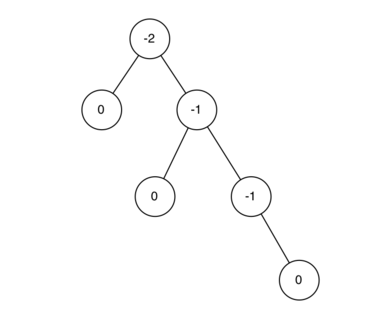
相比于二叉搜索树,AVL树的put和delete操作后,需要对节点的平衡因子进行更新,如果某个节点不平衡时,需要进行平衡处理,主要分为左旋转和右旋转。
左旋转:如图,节点A的平衡因子为-2(right heavy),不平衡,对其进行左旋转,即以A为旋转点,AB边逆时针旋转。
详细操作为:1,A的右节点B作为新的子树根节点
2,A成为B的左节点,如果B有左节点时,将其左节点变为A的右节点(A的右节点原来为B,所以A的右节点现在为空)

右旋转:如图,节点E的平衡因子为2(left heavy),不平衡,对其进行右旋转,即以E为旋转点,EC边顺时针旋转。
详细操作为:1,E的左节点C作为新的子树根节点
2,E成为C的右节点,如果C有右节点时,将其右节点变为E的左节点(E的左节点原来为C,所以E的左节点现在为空)
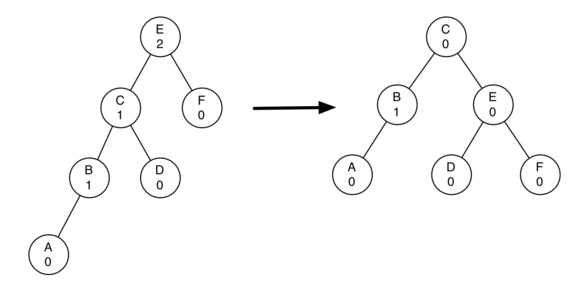
特殊情况:当出现下面的情况时,如图所示,A依旧为right heavy,但若进行左旋转,又会出现left heavy,无法完成平衡操作。 所以在进行左旋转和右旋转前需要进行一步判断,具体操作如下:
1,如果某节点需要进行左旋转平衡时(right heavy),检查其右子节点的平衡因子,若右子节点为left heavy,先对右子节点右旋转,然后对该节点左旋转
2,如果某节点需要进行右旋转平衡时(left heavy),检查其左子节点的平衡因子,若左子节点为right heavy,先对左子节点左旋转,然后对该节点右旋转
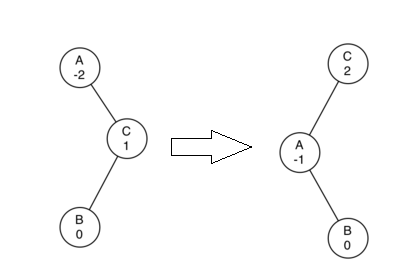
AVL tree用python实现的代码如下:

#coding:utf-8 from binarySearchTree import TreeNode, BinarySearchTree # class AVLTreeNode(TreeNode): # # def __init__(self,*args,**kwargs): # self.balanceFactor = 0 # super(AVLTreeNode,self).__init__(*args,**kwargs) class AVLTree(BinarySearchTree): def _put(self,key,value,currentNode): if currentNode.key<key: if currentNode.hasRightChild(): self._put(key,value,currentNode.rightChild) else: currentNode.rightChild=TreeNode(key,value,parent=currentNode) self.updateBalance(currentNode.rightChild) elif currentNode.key>key: if currentNode.hasLeftChild(): self._put(key,value,currentNode.leftChild) else: currentNode.leftChild=TreeNode(key,value,parent=currentNode) self.updateBalance(currentNode.leftChild) else: currentNode.replaceNodeData(key,value) def _del(self,currentNode): if currentNode.isLeaf(): if currentNode.isLeftChild(): currentNode.parent.leftChild = None currentNode.parent.balanceFactor -=1 elif currentNode.isRightChild(): currentNode.parent.rightChild = None currentNode.parent.balanceFactor += 1 if currentNode.parent.balanceFactor>1 or currentNode.parent.balanceFactor<-1: self.reblance(currentNode.parent) elif currentNode.hasBothChildren(): successor = currentNode.findSuccessor() #此处successor为其右子树的最小值,即最左边的值 # 先更新parent的balanceFactor if successor.isLeftChild(): successor.parent.balanceFactor -= 1 elif successor.isRightChild(): successor.parent.balanceFactor += 1 successor.spliceOut() currentNode.key = successor.key currentNode.value = successor.value # 删除后,再判断是否需要再平衡,然后进行再平衡操作 if successor.parent.balanceFactor>1 or successor.parent.balanceFactor<-1: self.reblance(successor.parent) elif currentNode.hasAnyChildren(): #先更新parent的balanceFactor if currentNode.isLeftChild(): currentNode.parent.balanceFactor -= 1 elif currentNode.isRightChild(): currentNode.parent.balanceFactor += 1 if currentNode.hasLeftChild(): if currentNode.isLeftChild(): currentNode.parent.leftChild = currentNode.leftChild currentNode.leftChild.parent = currentNode.parent elif currentNode.isRightChild(): currentNode.parent.rightChild = currentNode.leftChild currentNode.leftChild.parent = currentNode.parent else: # currentNode has no parent (is root) currentNode.replaceNodeData(currentNode.leftChild.key, currentNode.leftChild.value, currentNode.leftChild.leftChild, currentNode.leftChild.rightChild) elif currentNode.hasRightChild(): if currentNode.isLeftChild(): currentNode.parent.leftChild = currentNode.rightChild currentNode.rightChild.parent = currentNode.parent elif currentNode.isRightChild(): currentNode.parent.rightChild = currentNode.rightChild currentNode.rightChild.parent = currentNode.parent else: # currentNode has no parent (is root) currentNode.replaceNodeData(currentNode.rightChild.key, currentNode.rightChild.value, currentNode.rightChild.leftChild, currentNode.rightChild.rightChild) #删除后,再判断是否需要再平衡,然后进行再平衡操作 if currentNode.parent!=None: #不是根节点 if currentNode.parent.balanceFactor>1 or currentNode.parent.balanceFactor<-1: self.reblance(currentNode.parent) def updateBalance(self,node): if node.balanceFactor>1 or node.balanceFactor<-1: self.reblance(node) return if node.parent!=None: if node.isLeftChild(): node.parent.balanceFactor +=1 elif node.isRightChild(): node.parent.balanceFactor -=1 if node.parent.balanceFactor!=0: self.updateBalance(node.parent) def reblance(self,node): if node.balanceFactor>1: if node.leftChild.balanceFactor<0: self.rotateLeft(node.leftChild) self.rotateRight(node) elif node.balanceFactor<-1: if node.rightChild.balanceFactor>0: self.rotateRight(node.rightChild) self.rotateLeft(node) def rotateLeft(self,node): newroot = node.rightChild node.rightChild = newroot.leftChild if newroot.hasLeftChild(): newroot.leftChild.parent = node newroot.parent = node.parent if node.parent!=None: if node.isLeftChild(): node.parent.leftChild = newroot elif node.isRightChild(): node.parent.rightChild = newroot else: self.root = newroot newroot.leftChild = node node.parent = newroot node.balanceFactor = node.balanceFactor+1-min(newroot.balanceFactor,0) newroot.balanceFactor = newroot.balanceFactor+1+max(node.balanceFactor,0) def rotateRight(self,node): newroot = node.leftChild node.leftChild = newroot.rightChild if newroot.rightChild!=None: newroot.rightChild.parent = node newroot.parent = node.parent if node.parent!=None: if node.isLeftChild(): node.parent.leftChild = newroot elif node.isRightChild(): node.parent.rightChild = newroot else: self.root = newroot newroot.rightChild = node node.parent = newroot node.balanceFactor = node.balanceFactor-1-max(newroot.balanceFactor,0) newroot.balanceFactor = newroot.balanceFactor-1+min(node.balanceFactor,0) if __name__ == '__main__': mytree = AVLTree() mytree[8]="red" mytree[4]="blue" mytree[6]="yellow" mytree[5]="at" mytree[9]="cat" mytree[11]="mat" print(mytree[6]) print(mytree[5]) print '-'*12 print ('key','value','balanceFactor') for x in mytree: print x print 'root:',mytree.root.key del mytree[6] print '-'*12 print ('key','value','balanceFactor') for x in mytree: print x print 'root:',mytree.root.key
AVL Tree继承了二叉搜索树,对其插入和删除方法进行了重写,另外对TreeNode增加了balanceFactor属性。再进行左旋转和右旋转时,对于balanceFactor的需要计算一下,如图的左旋转过程中,D成为了新的根节点,只有B和D的平衡因子发生了变化,需要对其进行更新。(右旋转和左旋转类似)
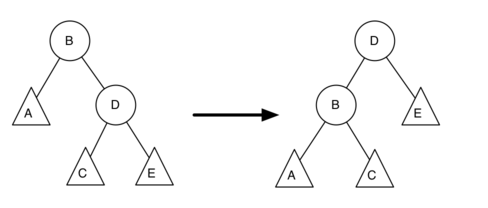
B的平衡因子计算过程如下:(newBal(B)为左旋转后B的平衡因子,oldBal(B)为原来的节点B的平衡因子,h为节点的高度)

D的平衡因子计算过程如下:

由于AVL Tree总是保持平衡,其put和get操作的复杂度能保持为O(log n)
7.总结
到目前为止,对于map(字典)数据结构,用二叉搜索树和AVL树实现了,也用有序列表和哈希表实现过,对应操作的复杂度如下:

8. 其他树形结构
8.1 哈夫曼树及哈夫曼编码
参考:http://www.cnblogs.com/mcgrady/p/3329825.html
哈夫曼树:哈夫曼树是一种带权路径长度最短的二叉树,也称为最优二叉树。 (权:叶子节点的权重;路径:根节点到叶子节点经过的线段)
下图中的带权路径长度分别为:
图a: WPL=5*2+7*2+2*2+13*2=54
图b: WPL=5*3+2*3+7*2+13*1=48
可见,图b的带权路径长度较小,我们可以证明图b就是哈夫曼树(也称为最优二叉树)。
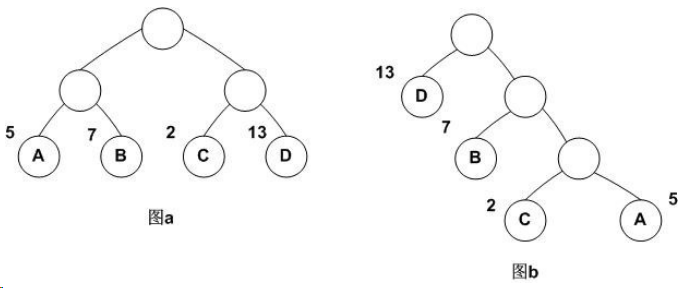
构建哈夫曼树步骤:
1,将所有左,右子树都为空的作为根节点。
2,在森林中选出两棵根节点的权值最小的树作为一棵新树的左,右子树,且置新树的附加根节点的权值为其左,右子树上根节点的权值之和。注意,左子树的权值应小于右子树的权值。
3,从森林中删除这两棵树,同时把新树加入到森林中。
4,重复2,3步骤,直到森林中只有一棵树为止,此树便是哈夫曼树。
下面是构建哈夫曼树的图解过程:
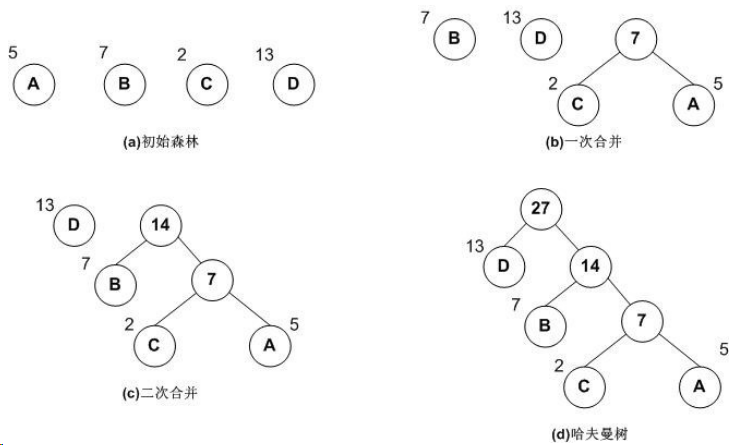
哈夫曼编码:利用哈夫曼树求得的用于通信的二进制编码称为哈夫曼编码。树中从根到每个叶子节点都有一条路径,对路径上的各分支约定指向左子树的分支表示”0”码,指向右子树的分支表示“1”码,取每条路径上的“0”或“1”的序列作为各个叶子节点对应的字符编码,即是哈夫曼编码。
上图A,B,C,D对应的哈夫曼编码分别为:111,10,110,0。 用图说明如下:

利用哈夫曼树编码字符窜和解码: 首先统计字符窜中每个字符出现的频率,以字符频率为权重建立哈夫曼树,得到每个字符的哈夫曼码,最后对字符窜编码。下面代码利用哈夫曼树对字符窜进行了编码和解码

#哈夫曼树节点 class HaffmanNode(object): def __init__(self,value=None,weight=None,leftchild=None,rightchild=None): #value为统计字符,weight为字符出现频率 self.value = value self.weight = weight self.leftchild=leftchild self.rightchild = rightchild def is_leaf(self): #判断是否为叶子节点 return not self.leftchild and not self.rightchild def __lt__(self,other): #用于两个对象间大小比较 return self.weight<other.weight #根据哈夫曼树获得哈夫曼码 def get_haffman_code(root,code,code_dict1,code_dict2): if root.is_leaf(): code_dict1[root.value]=code #进行编码时使用 code_dict2[code]=root.value #进行解码时使用 else: get_haffman_code(root.leftchild, code+'0',code_dict1,code_dict2) get_haffman_code(root.rightchild, code+'1',code_dict1,code_dict2) #根据字符频率构建哈夫曼树 import heapq def build_haffman_tree(weight_dict): hp=[] for value,weight in weight_dict.items(): #value为字符,weight为字符出现频率 heapq.heappush(hp,HaffmanNode(value,weight)) while len(hp)>1: left = heapq.heappop(hp) right = heapq.heappop(hp) parent = HaffmanNode(weight=left.weight+right.weight,leftchild=left,rightchild=right) heapq.heappush(hp,parent) return hp[0] #剩下最后元素即为haffman tree weight_dict = {} code_dict1={} code_dict2={} #对字符窜astr进行哈夫曼编码 def haff_encode(astr): for i in astr: if i not in weight_dict: weight_dict[i]=1 else: weight_dict[i]+=1 haffman_tree = build_haffman_tree(weight_dict) get_haffman_code(haffman_tree,'',code_dict1,code_dict2) encoded_astr = '' for i in astr: encoded_astr+=code_dict1[i] return encoded_astr #解码哈夫曼编码后的字符窜 def haff_decode(encoded_astr,code_dict2): code = '' astr='' for i in encoded_astr: code = code+i if code in code_dict2: astr+=code_dict2[code] code='' return astr astr="This is my big fancy house" encoded_astr=haff_encode(astr) print(encoded_astr) decoded_astr = haff_decode(encoded_astr,code_dict2) print(decoded_astr)
利用哈夫曼树压缩文件和解压缩:
参考:https://www.jianshu.com/p/4cbbfed4160b
https://github.com/gg-z/huffman_coding
https://gist.github.com/Arianxx/603dc688a4b68f207ada2c4534758637
8.2 Trie树(字典树)
Trie树:又称字典树或前缀树,储存单词字符,方便用来进行词频统计和前缀匹配。Trie tree如图所示: 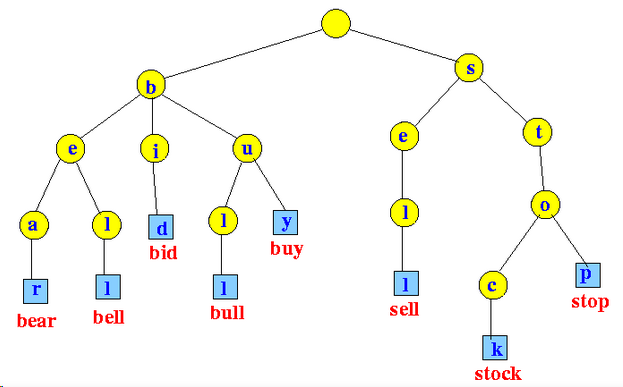
Trie树的特点:
除根节点外每个节点都包含字符
从根节点到叶子节点路径上的字符组成一个完成单词,
多个单词的共同路径节点即为公共前缀
Trie作用:
节约储存内存;
前缀匹配时,搜索更快,时间复杂度为O(n), (n为单词的长度)
下面代码用python实现了一个简单Trie Tree

#Trie树,字典树 class TrieNode(object): def __init__(self,char): self.char = char self.child=[] self.is_leaf = False #是否是叶子节点,即是否为一个完整单词的最后一个字母 self.counter = 1 #多少单词有这个共同前缀 class TrieTree(object): def __init__(self): self.root = TrieNode(None) #将一个单词加入到Trie树中 def add_trie_word(self,word): root = self.root for char in word: found = False for node in root.child: if node.char==char: node.counter+=1 root = node found = True break if not found: temp = TrieNode(char) root.child.append(temp) root = temp root.is_leaf=True #查找某个单词前缀是否在Trie树,并返回有多少个单词有这个共同前缀 def search_trie_prefix(self,prefix): root = self.root if not root.child: return False,0 for char in prefix: found=False for node in root.child: if node.char==char: root=node found=True break if not found: return False,0 return True,root.counter trie_tree = TrieTree() trie_tree.add_trie_word("hammer") trie_tree.add_trie_word("ham") trie_tree.add_trie_word("had") print(trie_tree.search_trie_prefix("ha")) print(trie_tree.search_trie_prefix("ham")) print(trie_tree.search_trie_prefix("had")) print(trie_tree.search_trie_prefix("b"))
Trie tree参考: https://www.cnblogs.com/huangxincheng/archive/2012/11/25/2788268.html
https://towardsdatascience.com/implementing-a-trie-data-structure-in-python-in-less-than-100-lines-of-code-a877ea23c1a1
参考:http://interactivepython.org/runestone/static/pythonds/Trees/toctree.html




